10 Office Team Building Activities (using only pens and paper)
November 19, 2015 : General Team Building
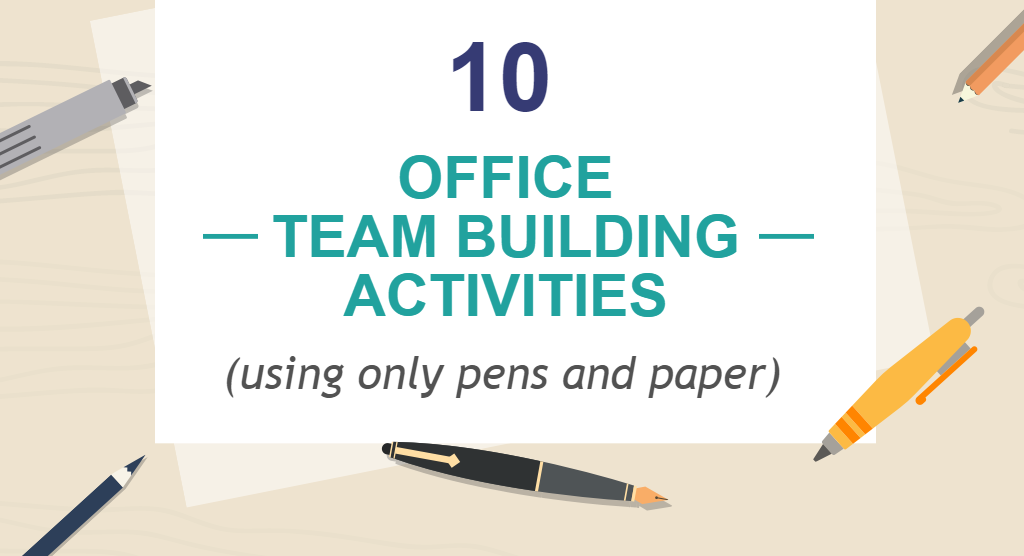
When it comes to team building in an office environment, many either face a range of health and safety restrictions or don’t have the desired amount of space to get creative with team building.
But who said you need loads of room to jump around to get creative with team building in the office?
That’s why we decided to create 10 office team building ideas, which only require the use of pens and paper, which every office environment has (we’d like to hope).
These team building methods will help a group of individuals in a number of ways, by increasing communication, promoting positive problem solving and creating a more relaxing and comfortable working atmosphere.
Also check out some of the onsite team building activities we’ve carried out in Glasgow and Aberdeen.
Choose from the list below or simply scroll.
“Creative Introductions”
Starting off a team building session is important, as it sets the tone for the rest of the activities ahead.
Here’s a fun, creative method of making introductions less awkward and more light-hearted, and a guaranteed success to an afternoon of team building.
Instructions:
1.) Ask each person “If you could be any cartoon character, which would it be?”
2.) Each person must then write there answer on a piece of paper, and hold the side with the answer on against their foreheads.
3.) Count to three, and ask the team members to turn their pieces of paper over, revealing their answers.
It’s important that your team feel comfortable and relaxed, but importantly are able to have a laugh with each other. Start your session with something boring, and just see how your team respond thereafter…
What are the desired outcomes?

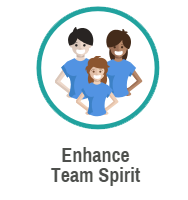
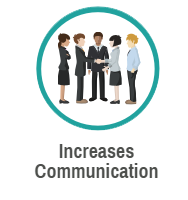
“A Negative Meeting”
More often than not, teams get together for various different meetings, and rather than coming out feeling uplifted and ready for the working day ahead, they actually feel the complete opposite effect.
*Sigh*
Which is where the “Negative Meeting” method comes in to effect.
Instructions:
1.) Make a list of negative phrases on some poster paper.
2.) During the meeting, if anybody uses these phrases, they must place 10p in the centre of the table.
If you continue to use this team building method for meetings, it will eliminate negative conversation and once the money jar gets fuller, this could go towards a team lunch time, outing for additional out of office team building.
What are the desired outcomes?
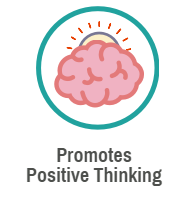


“Positive Statements”
Learning more about your team mates and valuing their opinions is a sure way of creating a more positive working atmosphere.
The “Positive Statements” technique has been tried and tested in many different varieties, and is always a great way to bring your group together and allow them to express their positive visions.
Instructions:
1.) Each team member finishes the sentence “My vision of a positive team is…”
2.) With these answers, the team creates one statement that represents all of these visions.
Although the example above is quite general and based around a positive team, you could customise this and make it specific to certain departments or roles within the company, a clever way for managers and team leaders to gain ideas and make these visions a reality.
What are the desired outcomes?
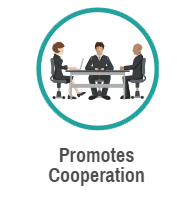

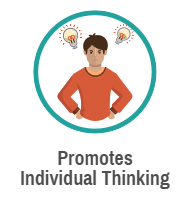
“The Sinking Boat”
What would you do if you were aboard a sinking boat? What would your first actions be? Who would you save first?
These are the kind of scenarios you’d pose to your friends after a few drinks perhaps, but who’s to say they can’t be effective in team building?
Instructions:
1.) Write a list of 11 controversial figures (e.g. a doctor, a priest, a pregnant woman etc) that are on a boat, which is slowly but surely sinking.
2.) There is only one lifeboat. The teams must then list, in order of importance, which of the people should go on the life boat.
3.) BUT, because they are running out of food and water, the “less important people” will be left behind.
4.) Assign a period of time (around 10 minutes) for them to work out the problem.
5.) After the time is up, discuss the lists in depth and include everyone within the teams.
Some examples of questions you could ask:
– What was the biggest problem you experienced?
– How did you resolve these issues?
– If you could have listed in differently, would you have?
– Why did these problems occur?
6.) To complete the ask, now ask the teams to list three things they would have done differently and discuss these changes further.
These kind of team building tasks are all about bringing your groups together and making them work and think as a team, whilst improving communication and having a little fun at the same time.
What are the desired outcomes?
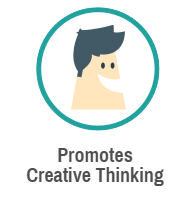


“Admiration”
Keeping individuals motivated and feeling positive about themselves and the work they’re producing is key to a happy team and vibrant working atmosphere.
Learning more about your team and what they admire about people is a proven way to spark discussion amongst teams and for managers and team leaders to learn more about their teams on a personal level.
Instructions:
1.) First things first, each person in the group writes down the words “I admire people that…”
2.) Ask the group to think of any person in the world they admire and why, give each person 2 minutes to think of their answer.
3.) Ask a few people in the group to share their answers, starting with the introductory sentence.
4.) Now ask each person to draw a line through the introductory sentence and insert “I am powerful when I” and ask the volunteers to read their answers again.
These kind of team building tasks are all about bringing your groups together and making them work and think as a team, whilst improving communication and having a little fun at the same time.
What are the desired outcomes?
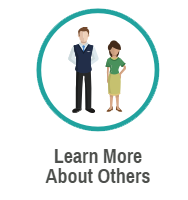


“Open the Treasure Chest”
“Open the Treasure Chest” is an effective method to discover the things that truly matter to individuals.
This task aims to find out more about your teams goals and achievements, whilst promoting solution orientated thinking and therefore, putting this in to practice in the workplace.
Instructions:
1.) Ask each person to write down everything they want in their life, this can be things they already have and others they desire.
2.) Give those 10 minutes to complete the task, writing down one thing per piece of paper. Suggest that they write fast and include essentials first.
3.) Once complete, ask them to put their answers in a cardboard box.
4.) The last step is to ask them to pick their answers out of the box, and write down solutions on how to get the things they want.
What are the desired outcomes?

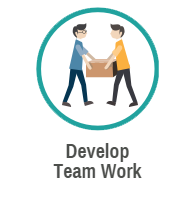
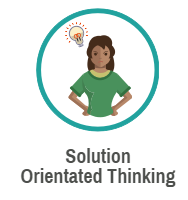
“Wheel of Fortune”
Don’t worry, nobody is expected to dress up as Nicky Campbell or Bradley Walsh and host a quiz game, this version of Wheel of Fortune is all about working together to real workplace problems.
This task itself is a very short and quick, which is also a way or promoting quick thinking and important decision making.
Instructions:
1.) Tell your group to imagine they’ve just inherited a warehouse full of hula hoops.
2.) Give them 30 seconds to write down what they would do with them.
3.) Once complete, ask each person/group to share their ideas
4.) After this, turn to the “real” workplace problem you’re trying to solve and relate it to this task.
What are the desired outcomes?



“The Paper Tower”
Don’t worry, nobody is expected to dress up as Nicky Campbell or Bradley Walsh and host a quiz game, this version of Wheel of Fortune is all about working together to solve real workplace problems.
Instructions:
1.) Hand each person a piece of paper and ask them to create the tallest free-standing structure possible, in just 5 minutes
2.) Once the 5 minutes is up, the group can discuss how they planned out their structures, whether people ran out of time and what they’d have done differently.
3.) The person that creates the tallest paper tower is given permission to destroy the remaining (if they wish!)
What are the desired outcomes?



“A Boss Discussion”
The Boss Discussion technique is another light-hearted task that promotes communication and giving people the chance to share and express there past work experiences.
It’s not all just about bad mouthing your ex-boss, but a way of getting the team members to communicate and win some fun prizes.
Instructions:
1.) Ask each person to write down their favourite and least favourite boss at a previous job, and why they liked/disliked them.
2.) After about 5 minutes, let the group discuss their past experiences with bosses.
3.) Let the group vote for the top 5 answers and each of these will get a prize, such as an extended lunch hour.
What are the desired outcomes?



“A Dream Workplace”
Allowing your team members to be imaginative is another way to spark creativity and out of the box thinking.
“A Dream Workplace” is another simple yet effective technique, which promotes individual thinking whilst increasing motivation and communication throughout the team.
Instructions:
1.) Hand each team member a piece of paper and ask them to draw their perfect workplace, with no rules or regulations.
2.) After about 10 minutes, ask the group to show their drawings and explain the main points involved.
3.) As a group, pick one idea from everybody’s drawings and combine them in to one.
4.) Write these ideas down and put them in your work suggestion box or hand it in to HR, this allows your team to get their points put across and heard.
What are the desired outcomes?




